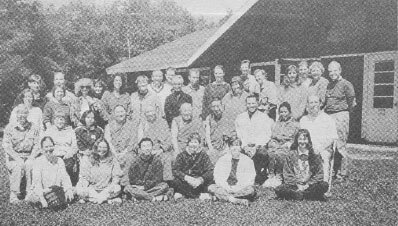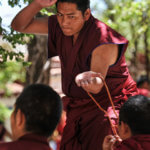| The following article is from the Winter, 1995 issue of the Snow Lion Newsletter and is for historical reference only. You can see this in context of the original newsletter here. |
H.H. the Dalai Lama Appoints
Ven. Khensur Lobsang Tenzin Rinpoche (Geshe Wangdak)
As Head Teacher and Abbot at
Namgyal Monastery
Institute of Buddhist Studies in Ithaca, NY.
H.H. the Dalai Lama has appointed Khensur Lobsang Tenzin Rinpoche (a.k.a Geshe Wangdak), a lharampa geshe from Drepung Loseling and former abbot of Namgyal Monastery in Dharamsala, India, as senior teacher at Namgyal Institute and as Abbot of Namgyal Monastery's North American Seat. The appointment in Ithaca is for a three-year period. Rinpoche will be joining the faculty this coming May along with Ven. Tenzin Yignyen. They are replacing Geshe Tenzin Rabgye and Ven. Dhondup Gyaltsen, who will be returning to the parent monastery in Dharamsala.
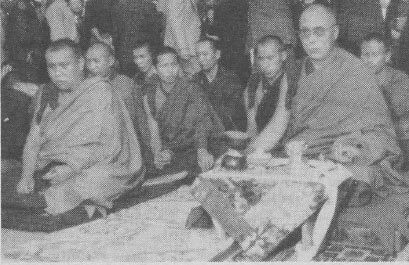
H.H. Dalai Lama [front right] and Khensur Lobsang Teiizin Rinpoche [front left] during a religious observance.
Short Biography of Geshe Wangdak Khensur Rinpoche
Khensur Lobsang Tenzin Rinpoche (a.k.a. Geshe Wangdak) was born around 1935 in Kham, Eastern Tibet. He entered Drepung Loseling Monastery and completed all of his studies in Tibet before his escape to India in 1959. Once in India, he took the geshe examination and was awarded the highest rank Geshe Lharampa degree.
There are four types of geshe degrees, Dorampa, Lingtse, Tsorampa and Lharampa being the highest. The primary units of study for the geshe degree are:
- Monastic discipline
- Abhidharma
- Epistemology
- The Middle Way School
- Perfection of wisdom
A monk who successfully completes all aspects of this program of study may then compete for the degree of geshe. Very few of those who begin the training program ever earn this degree, since the program may take from fifteen to twenty-five years and is extremely rigorous. The primary method of examination is oral debate, in which a monk must be able quickly to size up a wide range of philosophical positions, defend any of them against any other, and triumph (or at least hold one's own) in a no-holds-barred contest.
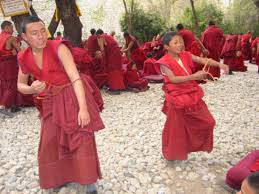
Candidates for the geshe degree must first pass oral examinations at their own monasteries in all of the five subjects listed above. They must pass a second set of examinations in their primary monastic university. Those wishing to earn the degree of "geshe lharampa" must then pass the most difficult of all examinations.
Candidates for the geshe lharampa degree are examined by the greatest scholars: the Dalai Lama, the throne holder of Ganden, the senior tutor of the Dalai Lama, the junior tutor, the seven assistant tutors, the "Jangtse Choje" and the "Sharpa Choje." The assistant tutors are drawn from the seven main monastic colleges, each of which appoints one tutor. They are appointed by the respective abbots of the monasteries and are geshes who have been chosen for their scholarship and debating skills.
After successfully completing these examinations, the candidates for the degree of geshe Lharampa are subjected to yet another round of examinations. These are conducted annually during the Monlam festival, which is held for several weeks after the Tibetan New Year. During the examination period, monks, geshes, and abbots from the major monasteries gather for the examination.
The geshe lharampa candidates are subjected to questions from all sides and must demonstrate a comprehensive knowledge of Buddhist scriptures and unusual skill in debate. Each year, only a few of the geshe candidates are awarded the degree of Lharampa, which is a recognition of superior scholarship and debating prowess. Following this, the geshe lharampa pursues intense tantric practice and study and assumes an important monastic teaching position.
A brilliant scholar and outstanding practitioner, Khensur Rinpoche (Geshe Wangdak) taught at the Institute of Higher Tibetan Studies in Sarnath, India until 1976, when he was asked by His Holiness the Dalai Lama to teach at his personal monastery, Namgyal Monastery. He became known as a master of both sutra and tantra, as well as a popular teacher to monks, lay Tibetans and westerners.
Khensur Rinpoche (Geshe Wangdak) was appointed Abbot of Namgyal Monastery in 1991 and held that position for the following three years, teaching advanced philosophy and tantra. Western students at Namgyal Ithaca are extraordinarily fortunate to have a resident senior teacher of Rinpoche's stature who is known for his abilities as a teacher and administrator, his humble and kind nature, and outstanding scholarship.
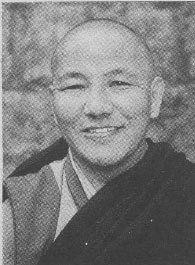
Ven. Tenzin Yignyen
Ven. Tenzin Yignyen
Ven. Tenzin Yignyen was born in Phari, Southern Tibet. He was only six years old when he escaped into India. He was among the first graduating class of the relocated Namgyal Monastery educational program. After 15 years of study and practice he received the degree of Master of Sutra and Tantra.
He has specialized in the practices of Guhyasamaja, Heruka, Yamantaka and Kalachakra. He has also studied mandala construction, ritual dance, monastic music and other religious arts.
Ven. Yignyen has traveled as a member of the entourage of His Holiness the XIV Dalai Lama on many occasions. Fluent in English, he has worked with many westerners seeking guidance at Namgyal Monastery. Ven. Tenzin Yignyen has traveled throughout the world creating exquisite sand mandalas, and recently spent one year translating sacred Kalachakra literature and explaining the philosophical meanings of Kalachakra for the book The Wheel of Time Sand Mandala (1992, Harper Collins).
